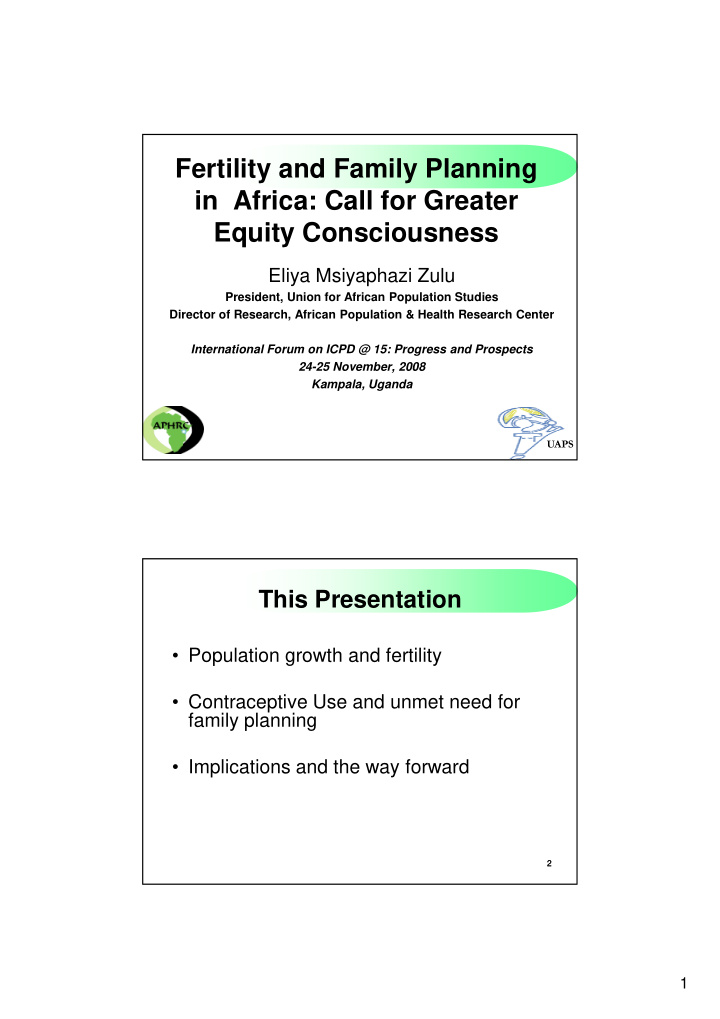



Fertility and Family Planning in Africa: Call for Greater Equity Consciousness Eliya Msiyaphazi Zulu President, Union for African Population Studies Director of Research, African Population & Health Research Center International Forum on ICPD @ 15: Progress and Prospects 24-25 November, 2008 Kampala, Uganda ���� This Presentation • Population growth and fertility • Contraceptive Use and unmet need for family planning • Implications and the way forward 2 2 1
Sub-Saharan Africa has made progress in reducing fertility and population growth rates ������������������������������� 3 3 But there are big variations across the continent’s major regions… 2.8 Africa - Southern 0.8 3.0 Africa - Northern 1.9 5.4 Africa - Eastern 2.5 5.7 Africa - Western 2.6 6.1 Africa - Middle 2.8 5.4 Africa - Sub-… 2.5 4.9 Africa 2.4 0 2 4 6 8 Total Fertility Rates (2008) Rate of Natural Increase 4 2
Population Projections for Africa (2008-2050) (Millions) % REGION 2008 2025 2050 change Africa 967 1,358 1,932 100 Africa - Sub-Saharan 809 1,161 1,698 110 Africa - Middle 122 189 306 151 Africa - Eastern 301 440 641 113 Africa - Western 291 419 616 112 Africa - Northern 197 251 307 56 Africa - Southern 55 59 62 12 5 ����������������������������������������� Africa’s population is growing more rapidly than other regions REGION 2008 2050% change Africa 967 1,932 100 Africa - Sub-Saharan 809 1,698 110 Africa - Middle 122 306 151 Africa - Eastern 301 641 113 Africa - Western 291 616 112 Africa - Northern 197 307 56 Africa - Southern 55 62 12 Americas 915 1,258 37 Asia 4,052 5,427 34 Asia (excl. China) 2,728 3,990 46 World 6,705 9,352 39 6 ����������������������������������������� 3
Illustrating the Challenge: Niger Indicator Value Year Current Population 14 m 2005 Projected Pop. (Constant fertility 7.5) 82 m 2050 Projected Pop. (Fertility declines 3.6) 50 m 2050 Total Fertility Rate 7.5 1998 Mean Desired Family Size 8.2 1998 Modern Cont. use (married women) 4.6% 1998 8 8 Source: World Population Data, 2007 4
Variations are smaller but levels higher in West and Central Africa Gabon Cameroon Cote d'Ivoire Central African Republic Gambia Congo Senegal Guinea Nigeria Burkina Faso Chad Congo, Dem. Rep. of Mali Liberia Guinea-Bissau Niger 0.0 1.0 2.0 3.0 4.0 5.0 6.0 7.0 8.0 9 Unmet need for family planning is greater than met need in many countries 10 5
A big percentage of recent births were mistimed or unwanted Wanted Later Not Wanted Total Mauritius 9 12 20 Tanzania 11 11 22 Mozambique 20 4 24 Madagascar 14 12 26 Namibia 21 12 34 Zambia 29 7 36 Zimbabwe 30 7 37 Malawi 18 22 40 11 11 Demand for Contraception is High: More women would like to stop childbearing Source: ORC Macro, 2008. MEASURE DHS 12 12 6
Fertility & ideal family size by wealth status, Tanzania 2004 Source: Tanzania DHS, 2004 13 13 What’s driving the high fertility of the poor? (Kenya 2003) 48 50 40 40 36 35 TFR/Percent 30 30 24 22 21 20 15 13 10 8 6 5 4 3 0 Poorest Second Middle Fourth Richest TFR CPR Unmet Need �������������������������������������������������������������� ��������� 14 !�"��#$$% 7
Fertility decline mostly happening among the rich ����&���'����������������������������� ���������"� Use of family planning mostly increasing among the more educated COUNTRY No Education Primary Secondary+ Burkina Faso 1 2 13 32 Burkina Faso 2 2 20 43 Niger 1 2 7 29 Niger 2 3 11 29 Kenya 1 15 29 45 Kenya 2 8 26 52 Uganda 1 3 8 26 Uganda 2 9 17 35 16 ������������������� 8
Reasons for not using family planning methods COUNTRY % % % Burkina Faso 50 17 24 Senegal 29 42 26 Ghana 41 12 43 Niger 39 29 26 Kenya 40 31 26 Malawi 39 16 39 Uganda 38 18 40 17 ������������������� Other key Inequities • The rapidly expanding population of slum dwellers doing much worse than other urban residents and in some cases worse than rural residents • Yet, virtually all future population growth to emanate from urban areas 18 9
Way Forward: Embrace equity approach to improve access • Need for recommitment to address the huge inequities in access to contraception within and across countries/regions � The poor in general � The less educated � Rural residents � Slum dwellers � Rural residents � Central and West Africa 19 19 ��������������� ���������!���������� !��"�������"�������#�����$����� ��%���$���������� Average real Poverty Gini GDP growth rate, coefficient, ��&��������'()*����%���$� rate, at factor 2012 2012 �������������������������� cost, 2009-12 "�$����������������#�����$�� ������������������ Base case 5.9 37.7 0.431 �����������������$�!������� Scenario #1: 11.9 28.0 0.431 ��������������+������� Constant ������,�� inequality, 2012 poverty -�����#�����$�������������� target "�����������������������&���� Scenario #2: 4.7 28.0 0.350 &����������������������� Lower ��%���$�����������������$���� inequality �����&������%����&���� Scenario #3: 21.3 28.0 0.481 ����������&������������$,� Increasing inequality 10
�������������� �������������������� ������������������������ 21 ./�� 11
Recommend
More recommend